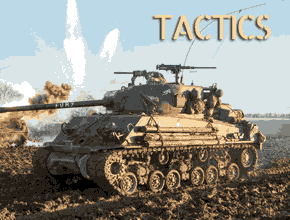The M39 armored utility vehicle (T41) is an American armored vehicle designed during the Second World War, which saw service in that conflict and in the Korean War. Like a number of vehicles of this type, it was built using an existing chassis, that of the M18 Hellcat. This was the first U.S. armoured personal carrier of WW2, and there was no shortage of ideas, derived from allied experiments like the Kangaroo. The M39 arrived in Germany in the last days of the war, and really was used in strenght in Korea, quickly replaced hy a new generation such as the M52.
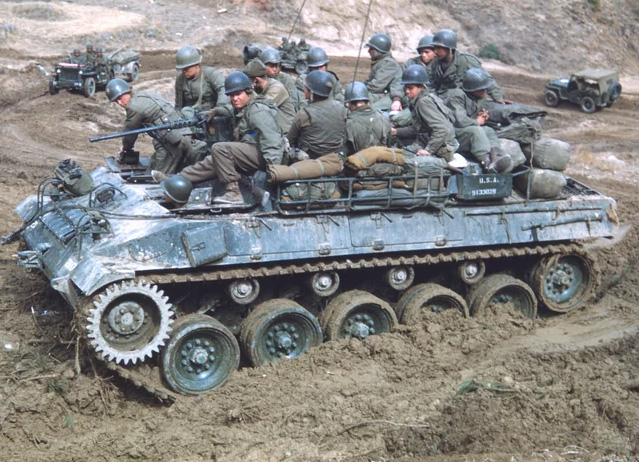
The positive test results lead to an urgent initial order for 100 of the new 3-inch guns. At this point the decision was made to send an example to the Field Artillery Board for further testing. This Board recommended numerous detail changes in the design. Further, and worse, the intended using arm – the Tank Destroyer Branch – soundly rejected the gun, instead preferring self-propelled antitank guns (which, incidentally, they were already using). Infantry panned the weapon because of its substantial (4,870 pound) weight and 23-foot, 4-inch length. Both the Tank Destroyers and Infantry asked that further procurement of the 3-inch guns be cancelled.
Chief of Ordnance General Levin H. Campbell was aghast, stating that this would be “…a definite mistake in view of recent executions of the 88mm in Libya.” Enter General Lesly McNair, head of Army Ground Forces, a former redleg [nickname for a U.S. artilleryman because of the red piping that ran down the pant leg of their early uniforms] who held that self-propelled antitank guns were a waste. Overruling his subordinates, which included head of the Tank Destroyer Center, General A.D.Bruce, in August 1942 he ordered the procurement of 1,000 of the 3-inch guns. The weapons were designated M5 on Carriage M1 and McNair also ordered them to be restudied by the Tank Destroyer Board, basing his argument in part on the fact that the gun could be unloaded at ports that lacked the facilities to lift armored vehicles.
Despite General Bruce’s objections, which included pointing out that a towed battalion required 300 more men, plus additional shipboard transport space for the prime movers, a 3-inch gun was sent to Fort Hood for further testing. The Tank Destroyer Board made several recommendations for improvement, which were almost universally ignored. Production began in December 1942, with 250 of the weapons being delivered that month. These were following by 200 in January 1943, 190 in February, 100 each in March through May and the final 60 in June. On New Year’s Day 1943 McNair ordered that a self-propelled battalion be converted to towed in order to test the new weapon in the field. The 801st Tank Destroyer Battalion was converted 24 May 1943 from the M3 Gun Motor Carriage to operate instead under new (as of 7 May 1943) Table of Organization and Equipment 18-35 to test McNair’s theory.
One-week later McNair ordered that half of all tank destroyer battalions be converted from self-propelled to towed battalions. Each Battalion included 36 of the guns, divided into three companies of 12 each, with associated prime movers. In November 1943 an improved gun carriage was introduced, which included a new sloping gun shield design. The new carriage was designated M6, and as a result, in November 1943 the weapon was standardized as the 3-inch Antitank gun M5 on Carriage M6. With the exception of a few of the early guns sent to Italy in 1943 all the guns sent to Europe used carriages. Fifth Army tank destroyer conference held in Florence in November 1944 wrote to Washington:
The Battle of the Bulge put towed antitank artillery to the test, particularly the M5. In the first few days of the German advance, the 820th Tank Destroyer Battalion lost 31 of its 36 guns, while the adjacent 801st lost 15 of the weapons. One antitank company commander noted
On 26 June 1944, the Ordnance Committee approved the production of 650 T41 prime movers, from earlier M18 Hellcat tank destroyers returned under the new Ordnance directive, to the Buick factory in March, to fix issues with their transmission gear ratios, and incorporate later batches modifications. In November 1944, the order for T41s was reduced by ten, and eventially the design was standardized as the "Armored, utility vehicle, M39". The ten additional T41s were converted to T41E1s to be tested on the European Theater, but never standardized. Both saw limited service beginning from April 1945. They were never moved the Pacific threater. The main problem was the phasing out of the 3-inch gun starting in early 1945, in favor of self-propelled tank destroyers. By March 1945, reports from Europe also indicated the M39 needed and armored roof to better protect the crew.
It could be used armored personnel carrier, though open-topped, carrying the gun crews of the towed anti-tank guns or other artillery ordnance. Like the M18 it was praised for mobility but criticized for being open-topped and lightly armored. As the Korean war took an ugly turn when Chinese troops counter-attacked en massed, it was sometimes pressed into battle roles in emergencies. The open compartment could accomodate for example a mortar, keeping the crew inside relatively protected and enabling close relocation. It thus proved useful in rapid movement of infantry after supporting tank destroyer battalions in dying days of the war in late April and May. It paved the way for fully enclosed APCs like the M75 and M59. It was also a notable example of U.S. adaptability—turning an existing tank destroyer into a multi-role support vehicle.
There were bulkheads around a central well, as a major difference from the M18, which hull had a turret ring. This rectalngular opening was protected on both sides by storage bins, and the folding seats were placed side by side in the middle four either side. When used specifically as ammo vehicle, it was equipped with an SCR-610 radio and stowage space for 42 rounds of 3-inch ammunition. The command variant T41E1 (10 vehicles) were given instead a more capable, longer range SCR-506 or SCR-608 radio in addition to the SCR-610 srt, but with an auxiliary generator. In that case the crew could be seven passengers total. In both cases, the hull also hosted a bazooka and three antitank mines for self-defense in the reconnaissance role.
November 1944: 60 serials 13-72
December 1944: 163 serials 73-235
January 1945: 150 serials 236-385
February 1945: 150 serials 386-535
March 1945: 107 serials 536-642
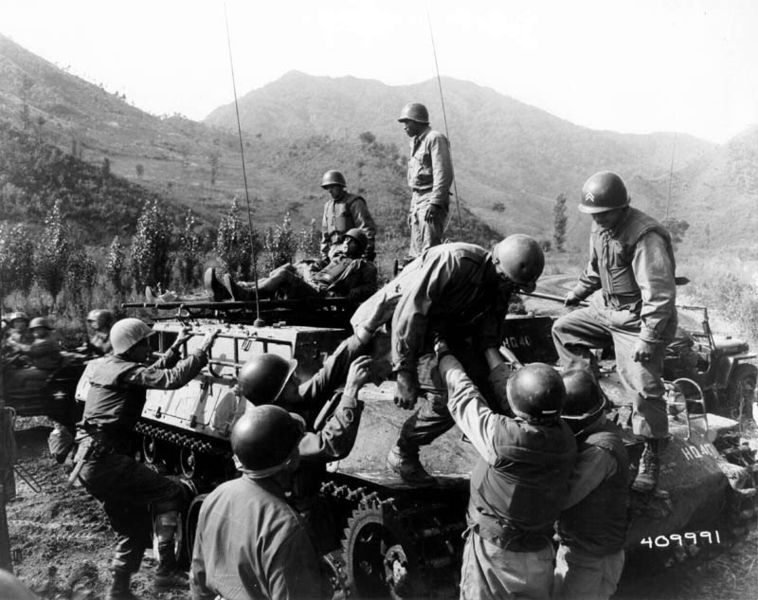
M39 Ambutank in Korea (Carrier Medical corpsmen)
As said above, a towed TD battalion possessed 36 cannons in three companies of twelve, all towed by M3 Halftracks as prime movers in 1942. But in two years of grualling campaign, experience returnse were unanimous about the inadequacy of the M3 for this. A complete reorganization from 1 September 1944 authorized M39 armored utility vehicles to act as prime movers, only reaching the frontline in spring 1945, basically in April-May. Despite of this, AT teams still asked repeatedly for self-propelled tank destroyers which offered better protection, with that gun. The transition was only acted on 11 January 1945 by the War Department. However it was too late to be enacted en masse when the war ended in Europe by May. There was no need for such units given the rare and light Japanese Tanks to be cnecountered in Operation Olympic.
Thus, the M39s were declared surplus as prime movers and mothballed in 1946. They were exhumed from depots when the Korean War broke out in 1950. No longer used as prime mover as the M5 AT gun had bee removed, they were instead used in a variety of roles, troop transports, armored ambulances, or ammunition carriers for 155mm M41 Gorilla self-propelled howitzers. M39s supplied and evacuated troops to isolated outposts notably in the later, defensive phase of the Korean War, while still found were vulnerable to enemy fire, snipers in thes mountaineous areas in particular. As soon as they were available, the fully enclosed M75 armored personnel carriers replaced them in that role.
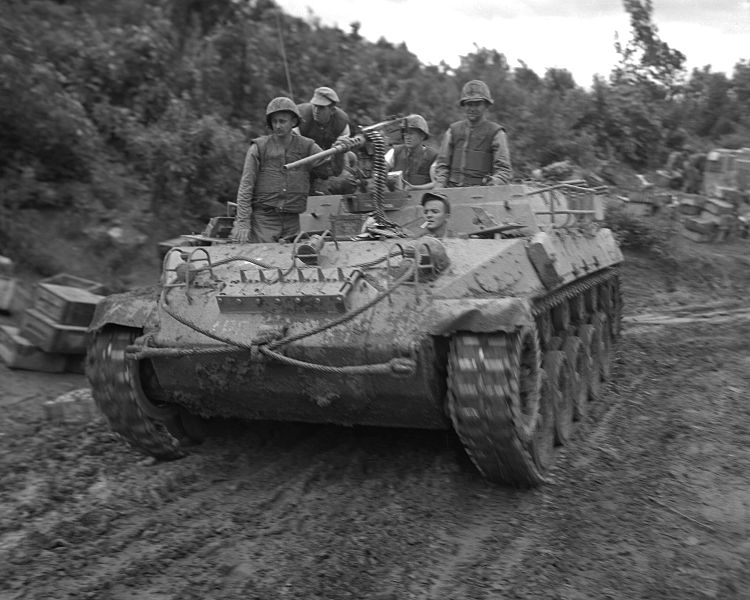
M39 underway
M38s took a priminent role in one ocasion in particular, the Ambush in the Battle of Imjin River. They were used as ammunition carriers in the African American 999th Armored Field Artillery Battalion taking part in the Imjin River battle, providing artillery support for the 1st Republic of Korea Infantry Division. Battery B was forced to evacuate and due to the bow-mounted .50 cal. machine guns, unlike the the M41 self-propelled howitzers, they led the retreating column, until ambushed by Chinese forces. The unit lost 7 killed in action, 31 wounded, two M39 were destroyed and two M41s damaged but it broke through while inflicting an estimated 100 casualties, later promptly resumed artillery support. The M39 was declared obsolete in 1957 and definitely phased out.
Use in the Bundeswehr: After the war in Korea, and before the vehicle was phased out, the United States offered 100 M39s to the young West German Bundeswehr in 1956, with 32 put into service, assigned to the Panzergrenadier-Lehrbataillon in Munster. After four years of service, they were replaced by the Schützenpanzer Lang HS.30 as spare parts were lacking. Both the M39 and M18 had been long retired and scrapped indeed by 1960.
The American M39 infantry fighting vehicle was the first infantry fighting vehicle to be delivered to the fledgling German Armed Forces in 1956, provided from US Army stocks.
In total, the Bundeswehr were offered approximately 100, however only 32 vehicles were actually purchased. Of the Bundeswehr's first armored infantry battalions, only the training battalion in Munster was so equipped with remaining battalions received trucks and planned to received German-built APCs later. The Panzergrenadier Training Battalion used the M39 as APC and Mortar carrier in training with wooden railway sleepers simulating the mortar. It proved to be exceptionally capable off-road, significantly superior to the M47 and M48 main battle tanks in manoeuvers, but in practice rarely fully operational due to a lack of spare parts. It took par tin the 1958 training exercise (LV 58) which caused many to broke down. With the introduction of the HS 30 "lang" as the first western European infantry fighting vehicle in 1960, whatever M39s were still operational were retired and the whole batch was latter scrapped.

Development of the M39 Utility Vehicle
In March 1944, the US Army Ordnance Depart. authorized conversion of two M18 tank destroyers as prime movers, for the "3-inch Gun M5, on Carriage M6". This was to provide a fast-towed antitank gun usable by tank destroyer battalions as well as armored command and reconnaissance vehicles. The result was the T41 and T41E1. At the time indeed, the 3-inch Gun M5 combined elements of the M2 105mm Howitzer with a tube and breech of the T9 AA gun and with 2,500 produced, it became the go-to antitank gun of the US Army. Albeit less punchy than the British 17-pdr, it was at the time towed "by default" by the M3 halftrack, which had extra soft ground capabilities the standard 6x6 trucks of the time lacked. But the latter was far from ideal.The need for the right prime mover
The increasing level of armor protection being seen in the conflict. It was rightly determined that the 37mm weapon was inadequate for the modern battlefield. Ordnance launched efforts to quickly develop a more powerful antitank weapon, first turning to an expedient 75mm weapon based on the M1897 before setting forth on 3-inch project. Utilizing the gun tube from the developmental 3-inch anti-aircraft gun T9, the antitank gun T10 was created. The antiaircraft barrel was combined with the breech, recoil mechanism, gun carriage, and shield of the 105mm howitzer M2. Testing of the new weapon began at Aberdeen Proving Ground in September 1941, and immediately the weapon proved superior to the concurrently developed expedient 75mm antitank gun.The positive test results lead to an urgent initial order for 100 of the new 3-inch guns. At this point the decision was made to send an example to the Field Artillery Board for further testing. This Board recommended numerous detail changes in the design. Further, and worse, the intended using arm – the Tank Destroyer Branch – soundly rejected the gun, instead preferring self-propelled antitank guns (which, incidentally, they were already using). Infantry panned the weapon because of its substantial (4,870 pound) weight and 23-foot, 4-inch length. Both the Tank Destroyers and Infantry asked that further procurement of the 3-inch guns be cancelled.
Chief of Ordnance General Levin H. Campbell was aghast, stating that this would be “…a definite mistake in view of recent executions of the 88mm in Libya.” Enter General Lesly McNair, head of Army Ground Forces, a former redleg [nickname for a U.S. artilleryman because of the red piping that ran down the pant leg of their early uniforms] who held that self-propelled antitank guns were a waste. Overruling his subordinates, which included head of the Tank Destroyer Center, General A.D.Bruce, in August 1942 he ordered the procurement of 1,000 of the 3-inch guns. The weapons were designated M5 on Carriage M1 and McNair also ordered them to be restudied by the Tank Destroyer Board, basing his argument in part on the fact that the gun could be unloaded at ports that lacked the facilities to lift armored vehicles.
Despite General Bruce’s objections, which included pointing out that a towed battalion required 300 more men, plus additional shipboard transport space for the prime movers, a 3-inch gun was sent to Fort Hood for further testing. The Tank Destroyer Board made several recommendations for improvement, which were almost universally ignored. Production began in December 1942, with 250 of the weapons being delivered that month. These were following by 200 in January 1943, 190 in February, 100 each in March through May and the final 60 in June. On New Year’s Day 1943 McNair ordered that a self-propelled battalion be converted to towed in order to test the new weapon in the field. The 801st Tank Destroyer Battalion was converted 24 May 1943 from the M3 Gun Motor Carriage to operate instead under new (as of 7 May 1943) Table of Organization and Equipment 18-35 to test McNair’s theory.
One-week later McNair ordered that half of all tank destroyer battalions be converted from self-propelled to towed battalions. Each Battalion included 36 of the guns, divided into three companies of 12 each, with associated prime movers. In November 1943 an improved gun carriage was introduced, which included a new sloping gun shield design. The new carriage was designated M6, and as a result, in November 1943 the weapon was standardized as the 3-inch Antitank gun M5 on Carriage M6. With the exception of a few of the early guns sent to Italy in 1943 all the guns sent to Europe used carriages. Fifth Army tank destroyer conference held in Florence in November 1944 wrote to Washington:
The conference is unanimous in the opinion that the towed battalion was unsatisfactory and grossly inferior to the SP-gun. It cannot be manned effectively in the forward combat area. Men cannot and will not stay with towed guns as they will with the M10 or M18.The 805th converted to the M18 Hellcat in July 1944 following the Anzio campaign. After the invasion at Normandy, it was quickly determined that the piece was difficult to maneuver in the hedgerow area, with crews struggling to place the gun, in part due to its weight, which now approached three tons, and in part due to the height of the hedgerows. Because of the size, the M5 was difficult to conceal, and crews were met with mortar and small arms fire. Units also quickly learned that the 3-inch gun was scarcely adequate against the Panther. By September Omar Bradley’s HQ had become disenchanted with all towed antitank battalions, and wrote to Eisenhower, protesting the Army Ground Forces plan of deploying 50 percent of the Tank Destroyer force in towed configuration. Bradley wanted no more than 12 of 52 Tank Destroyer Battalions in the ETO to be towed units, and then only if they were reequipped with the new T5E1 90mm gun.
The Battle of the Bulge put towed antitank artillery to the test, particularly the M5. In the first few days of the German advance, the 820th Tank Destroyer Battalion lost 31 of its 36 guns, while the adjacent 801st lost 15 of the weapons. One antitank company commander noted
“…I want the self-propelled guns rather than the towed 3in guns because the towed guns are too heavy and sluggish. You can’t get them up to the front. My orders have been in almost every case to get the guns up to the front-line troops. I just couldn’t do it in the daytime with the 3in towed gun.”This view pretty well summed up the view of troops in the field, and in January 1945 efforts were underway to convert all of the 12th Army Group’s 3-inch battalions to self-propelled battalions. The war in Europe ended in May with only four battalions remaining to convert.
About the M18 Hellcat
This Tank Destroyer as manufacturer by Buick, a division of General Motors and introduced in 1943 with a crew of 5 (commander, gunner, loader, driver, assistant driver) armed with the 76 mm M1 tank gun, coupled with a .50 cal machine gun. The focus was on speed and agility, with a light (5–25 mm) armour but a powerful 9-cylinder, 400 hp Continental R975-C4 for a top speed of 55 mph (88 km/h). The Nickname "Hellcat" stuck, notably because of the emblem of the most famous antitank unit at the time. The M18 played key roles in battles like the Battle of the Bulge and had one of the highest kill-to-loss ratios of any U.S. armored vehicle in WWII. It was the fastest U.S. armored vehicle of WWII and commanders learn to best use its mobility and ambush tactics to outmaneuver German tanks. Stripped of a turret, the T41 based on the same chassis was thus believed to be an even lighter, faster prime mover, with the limitation of the vibrations that the M5 gun and its carriage could bear.Tests with the T41
Tests with the T41 were "highly successful" but the Ordnance Department decided that the configuration of the T41E1, allowing for easy conversion between a prime mover and command vehicle, another gap in the US Army capabilities at the time, would better suit the needs of the program. All work on the T41 was stopped and the new "Utility Vehicle" was to be modular enough to be equipped either as a prime mover or command vehicle, and these would still respectively be referred to as T41 or T41E1, respectively still.On 26 June 1944, the Ordnance Committee approved the production of 650 T41 prime movers, from earlier M18 Hellcat tank destroyers returned under the new Ordnance directive, to the Buick factory in March, to fix issues with their transmission gear ratios, and incorporate later batches modifications. In November 1944, the order for T41s was reduced by ten, and eventially the design was standardized as the "Armored, utility vehicle, M39". The ten additional T41s were converted to T41E1s to be tested on the European Theater, but never standardized. Both saw limited service beginning from April 1945. They were never moved the Pacific threater. The main problem was the phasing out of the 3-inch gun starting in early 1945, in favor of self-propelled tank destroyers. By March 1945, reports from Europe also indicated the M39 needed and armored roof to better protect the crew.
Design
Originally designated as T41 before being standardized as M39 the vehicle was designed to be used on logistical support roles, after the roles of command vehicle and prime movers were dropped. After early 1945 when it was decided to convert to self propelled antitank units, it first role was as ammunition carrier for M18 units. This was easier for maintenance overall as both vehicles shared the same technical basis. It auyhorizeds also the conversion of destroyed M18s (turretless) to be converted as M39s. One variant was as Command vehicle, and thus a large part of the internal space was filled by two operators and powerful radio sets.It could be used armored personnel carrier, though open-topped, carrying the gun crews of the towed anti-tank guns or other artillery ordnance. Like the M18 it was praised for mobility but criticized for being open-topped and lightly armored. As the Korean war took an ugly turn when Chinese troops counter-attacked en massed, it was sometimes pressed into battle roles in emergencies. The open compartment could accomodate for example a mortar, keeping the crew inside relatively protected and enabling close relocation. It thus proved useful in rapid movement of infantry after supporting tank destroyer battalions in dying days of the war in late April and May. It paved the way for fully enclosed APCs like the M75 and M59. It was also a notable example of U.S. adaptability—turning an existing tank destroyer into a multi-role support vehicle.
General Layout
The T41 had a crew of two, but seating for up to eight passengers inside a relatively well protected hull. The driver and radio operator sat in the front, raised fighting compartment under armor protection. The commander's position was in the middle of the fighting compartment, which also accommodated up to 11 additional soldiers. The engine of the approximately 15-ton vehicle was located in the rear. The main armament consisted of an integrated, heavy .50 caliber (12.7 mm) M2 machine gun mounted on a rotating ring. The comparatively high fighting compartment, at around 2 meters, is noteworthy, making getting on and off the vehicle a real physical exercise.There were bulkheads around a central well, as a major difference from the M18, which hull had a turret ring. This rectalngular opening was protected on both sides by storage bins, and the folding seats were placed side by side in the middle four either side. When used specifically as ammo vehicle, it was equipped with an SCR-610 radio and stowage space for 42 rounds of 3-inch ammunition. The command variant T41E1 (10 vehicles) were given instead a more capable, longer range SCR-506 or SCR-608 radio in addition to the SCR-610 srt, but with an auxiliary generator. In that case the crew could be seven passengers total. In both cases, the hull also hosted a bazooka and three antitank mines for self-defense in the reconnaissance role.
Production
October 1944: 10 serials 3-12November 1944: 60 serials 13-72
December 1944: 163 serials 73-235
January 1945: 150 serials 236-385
February 1945: 150 serials 386-535
March 1945: 107 serials 536-642
Mobility
The M39 was of course shorter than the M18 which long barrel was an issue in tight landscapes. It was of course lighter than the original M18 at 33,450 lb (15.17 metric tons) versus 17.036 t for the fighting weight, with crew. So on average "only" 2 tons heavier. The M39 had the exact same powerplant as the M18, a Continental R975-C4 9 cylinder radial gasoline engine rated for 400 hp (298 kW) at 2,400 rpm. This meant a better power/weight ration than the M18 at 26.37 hp/metric ton. It was coupled with a 900T Torqmatic transmission with a 3 speeds forward, 1 reverse manual gearbox. The suspension comprised torsion bar on a 5 roadwheels chassis, front sprockets, rear idlers and 4 return rollers. Top speed was 50 mph (80 km/h) on road, governed, whereas in early trials the M18, light, could achieve up to 88 kph on flat. Thanks to its fuel capacity of 165 US gallons (625 litres) the M39 operational range was 100 miles (160 km) on road.Protection
Like the M18 the hull was poorly protected, with only from 4.8 to 12.7 mm (0.19-0.5 in). The thicker part was on the nose, with the sloped making it capable in theory to resist 20 mm FLAK guns. The remainder, and especially the back were protected only against small arms fire. The newly built bulkheads protected the seated men inside as high as their helmets, protruding. However in case of artillery fire with shrapnel, and like on the previous M3 Half Track used as prime mover, there was no overhead protection. There was no time to really appreciated this in WW2, but became a reccuring complain in Korea.Armament
It was about as high a standing man, with a pintle mount forward to support the only potent armament on board, a M2 Browning Heavy Machine Gun, with space for 900 rounds in multiple cases. The mount however was only usable on the froward arc and not well suited for AA defence. Experiments as APC meant more weapons could be carried, bazookas and mines notably in a reconnaissance AP mode in Korea, as well as a mortar.specifications | |
| Dimensions (L-w-H) | 17 ft 4 in x 9 ft 5 in x 6 ft 8 in (5.28 x 2.87 x 2.03 m) |
| Total weight, battle ready | 33,450 lb (15.17 metric tons) |
| Crew | 3: Driver, MG-gunner, operator |
| Propulsion | Continental R975-C4 9 cyl. radial gasoline 400 hp (298 kW)/2,400 rpm |
| Top speed | 50 mph (80 km/h) on road |
| Suspensions | Torsion bar |
| Range | 165 US gal. 100 miles (160 km) on road |
| Armament | 0.5 cal. (12.7 mm) Browning M2HB HMG, 900 rounds |
| Armor | 4.8-12.7 mm (0.19-0.5 in) |
The M39 Utility Vehicle in action

M39 Ambutank in Korea (Carrier Medical corpsmen)
As said above, a towed TD battalion possessed 36 cannons in three companies of twelve, all towed by M3 Halftracks as prime movers in 1942. But in two years of grualling campaign, experience returnse were unanimous about the inadequacy of the M3 for this. A complete reorganization from 1 September 1944 authorized M39 armored utility vehicles to act as prime movers, only reaching the frontline in spring 1945, basically in April-May. Despite of this, AT teams still asked repeatedly for self-propelled tank destroyers which offered better protection, with that gun. The transition was only acted on 11 January 1945 by the War Department. However it was too late to be enacted en masse when the war ended in Europe by May. There was no need for such units given the rare and light Japanese Tanks to be cnecountered in Operation Olympic.
Thus, the M39s were declared surplus as prime movers and mothballed in 1946. They were exhumed from depots when the Korean War broke out in 1950. No longer used as prime mover as the M5 AT gun had bee removed, they were instead used in a variety of roles, troop transports, armored ambulances, or ammunition carriers for 155mm M41 Gorilla self-propelled howitzers. M39s supplied and evacuated troops to isolated outposts notably in the later, defensive phase of the Korean War, while still found were vulnerable to enemy fire, snipers in thes mountaineous areas in particular. As soon as they were available, the fully enclosed M75 armored personnel carriers replaced them in that role.

M39 underway
M38s took a priminent role in one ocasion in particular, the Ambush in the Battle of Imjin River. They were used as ammunition carriers in the African American 999th Armored Field Artillery Battalion taking part in the Imjin River battle, providing artillery support for the 1st Republic of Korea Infantry Division. Battery B was forced to evacuate and due to the bow-mounted .50 cal. machine guns, unlike the the M41 self-propelled howitzers, they led the retreating column, until ambushed by Chinese forces. The unit lost 7 killed in action, 31 wounded, two M39 were destroyed and two M41s damaged but it broke through while inflicting an estimated 100 casualties, later promptly resumed artillery support. The M39 was declared obsolete in 1957 and definitely phased out.
 Schützenpanzer M39 (Bw)
Schützenpanzer M39 (Bw)
Use in the Bundeswehr: After the war in Korea, and before the vehicle was phased out, the United States offered 100 M39s to the young West German Bundeswehr in 1956, with 32 put into service, assigned to the Panzergrenadier-Lehrbataillon in Munster. After four years of service, they were replaced by the Schützenpanzer Lang HS.30 as spare parts were lacking. Both the M39 and M18 had been long retired and scrapped indeed by 1960.
The American M39 infantry fighting vehicle was the first infantry fighting vehicle to be delivered to the fledgling German Armed Forces in 1956, provided from US Army stocks.
In total, the Bundeswehr were offered approximately 100, however only 32 vehicles were actually purchased. Of the Bundeswehr's first armored infantry battalions, only the training battalion in Munster was so equipped with remaining battalions received trucks and planned to received German-built APCs later. The Panzergrenadier Training Battalion used the M39 as APC and Mortar carrier in training with wooden railway sleepers simulating the mortar. It proved to be exceptionally capable off-road, significantly superior to the M47 and M48 main battle tanks in manoeuvers, but in practice rarely fully operational due to a lack of spare parts. It took par tin the 1958 training exercise (LV 58) which caused many to broke down. With the introduction of the HS 30 "lang" as the first western European infantry fighting vehicle in 1960, whatever M39s were still operational were retired and the whole batch was latter scrapped.
Gallery
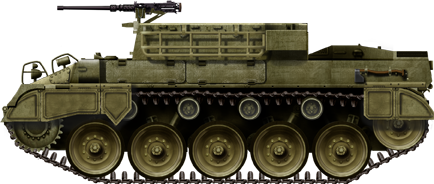
Basic M39 in initial version, May 1945.
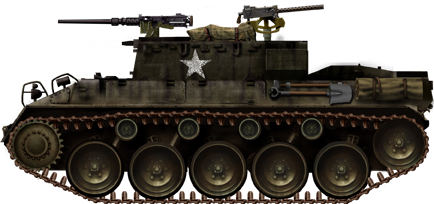
Worn out M39 in Korea, 1953, note the extra cal.30 LMG aft and absence of side skirts.
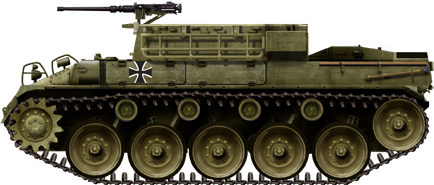
Schützenpanzer M39 (Bw), Panzergrenadier-Lehrbataillon Munster 1956-60



M39 us as APC, Korea in color

M39 AUV in Korea 1952/10/01
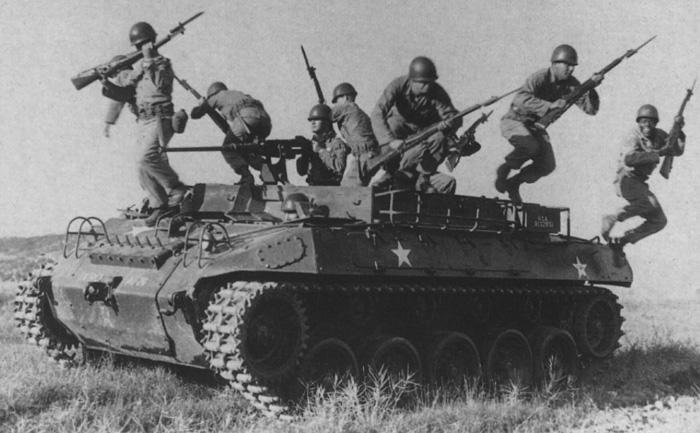
M39 APC dismounts demo
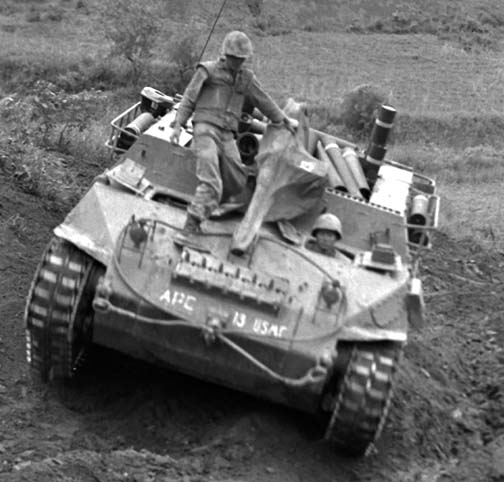
M39 AUV Korea 1953/05/29

M39 AUV Korea 1952/09/19
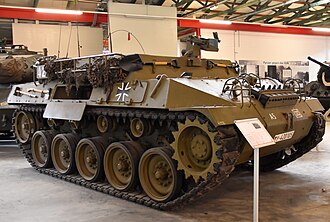
Schützenpanzer M39 in Munster
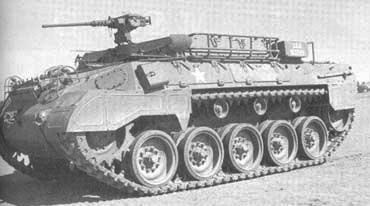
M39 AUV initial official doc. photo
Read More/Src
Books
Hunnicutt, Richard P. (1992). Stuart: A History of the American Light Tank, Volume 1. Novato, California: Presidio Press.Doyle, David (2020). M18 Hell-Cat: 76 mm Gun Motor Carriage in World War II. Atglen, Pennsylvania: Schiffer Publishing. p. 64.
Bowers, William T. (2011). Passing the Test: Combat in Korea April-June 1951. University Press of Kentucky. pp. 39–58.
Hunnicutt, Richard P. (1992). Stuart: A History of the American Light Tank, Volume 1. Novato, California: Presidio Press. p. 388.
Links
wbritain.comafvdb.50megs.com
the.shadock.free.fr
dieselfutures.tumblr.com
forum.enlisted.net
afvdb.50megs.com
en.topwar.ru/
commons.wikimedia.org
com-central.net
de.wikipedia.org/wiki/M39
panzerbaer.de Schützenpanzer M39 (Bw)
en.wikipedia.org 3-in gun
Versatile M39 Armored Vehicle: WWII to Korean War
Videos
Model Kits
On scalemates3D
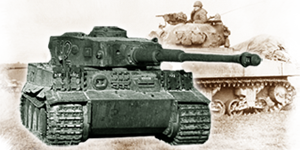
WW2 Tanks




























WW2 tanks posters
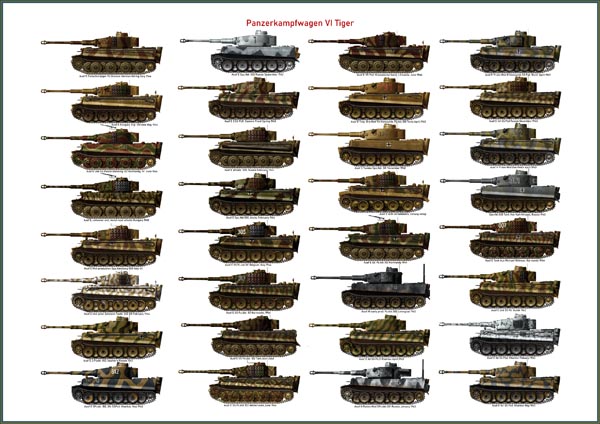
All Tiger tanks liveries.
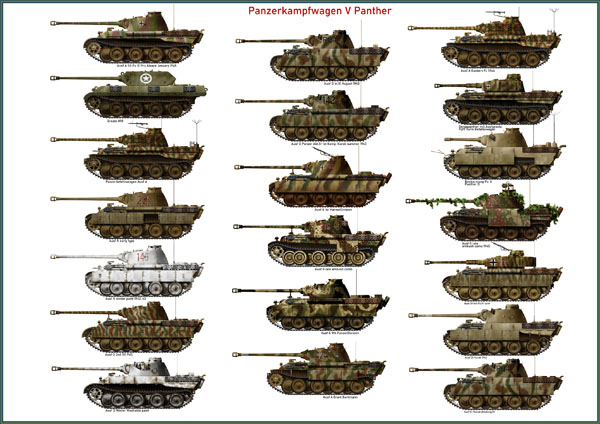
Panther liveries and variants
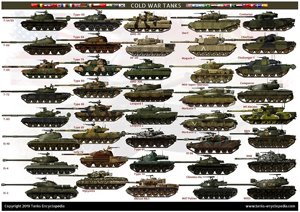
WW2 Armour - All tanks
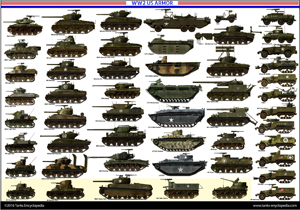










Tanks aces and single tanks series

Find more there
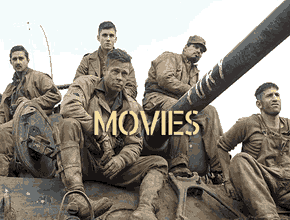
Museums, Movies, Books & Games
The Tanks and Armor in pop culture
Tanks and armored vehicles in general are only really grasped when seen first person: The mass, the scale, it's all there. Explore also the way tanks were covered in the movie industry, in books and in video games.Movies:
Best tanks movie on warhistoryonline.com
On imdb.com
On bestsimilar.com/
miltours.com
liveabout.com/
watchmojo.com
Video Games:
pcgamesn.com
historyhit.com
levvvel.com
vg247.com/best-tank-games
mmobomb.com/
alienwarearena.com
